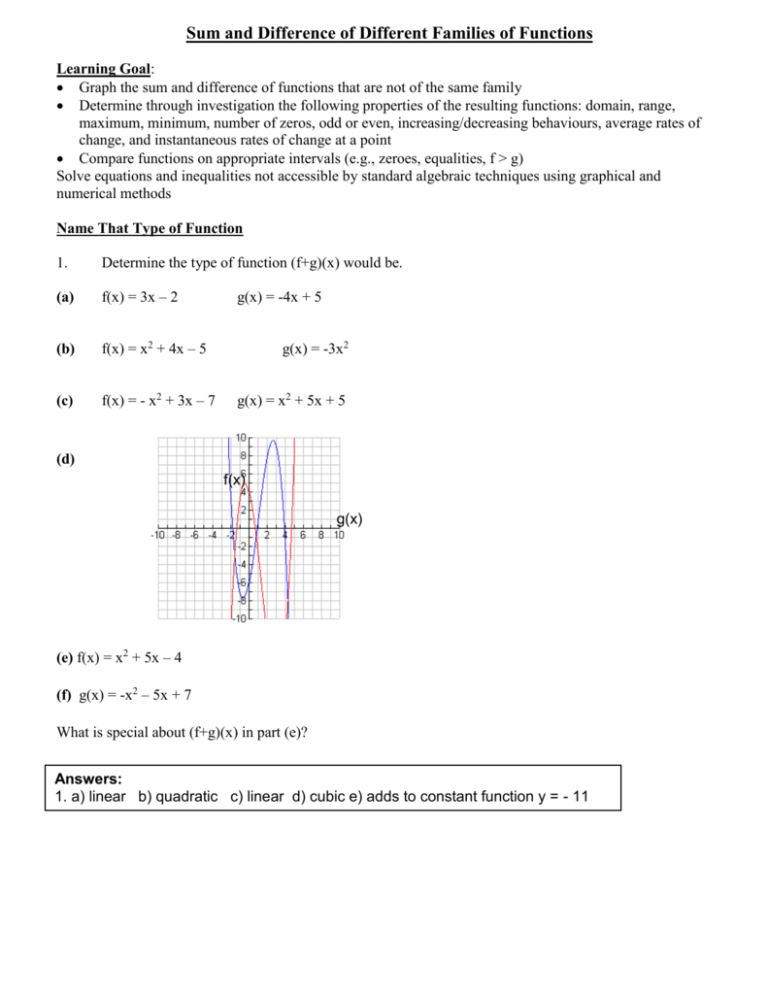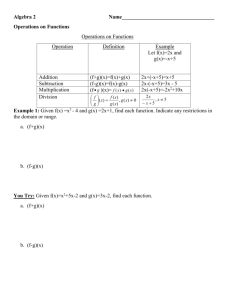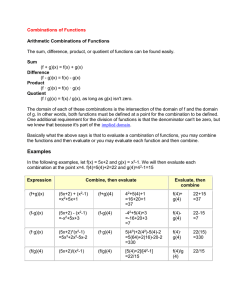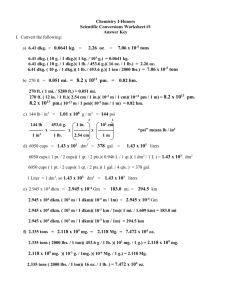Sum and Difference of Different Families of Functions
advertisement

Sum and Difference of Different Families of Functions
Learning Goal:
Graph the sum and difference of functions that are not of the same family
Determine through investigation the following properties of the resulting functions: domain, range,
maximum, minimum, number of zeros, odd or even, increasing/decreasing behaviours, average rates of
change, and instantaneous rates of change at a point
Compare functions on appropriate intervals (e.g., zeroes, equalities, f > g)
Solve equations and inequalities not accessible by standard algebraic techniques using graphical and
numerical methods
Name That Type of Function
1.
Determine the type of function (f+g)(x) would be.
(a)
f(x) = 3x – 2
(b)
f(x) = x2 + 4x – 5
(c)
f(x) = - x2 + 3x – 7
g(x) = -4x + 5
g(x) = -3x2
g(x) = x2 + 5x + 5
(d)
f(x)
g(x)
(e) f(x) = x2 + 5x – 4
(f) g(x) = -x2 – 5x + 7
What is special about (f+g)(x) in part (e)?
Answers:
1. a) linear b) quadratic c) linear d) cubic e) adds to constant function y = - 11
Sum and Difference of Functions of Different Families
Sum
(f + g)(x) = f(x) + g(x)
Difference
(f - g)(x) = f(x) - g(x)
Example 1:
In the following examples, let f(x) = 5x+2 and g(x) = x2-1. We will then evaluate each combination at the
point x=4. f(4)=5(4)+2=22 and g(4)=42-1=15
Expression
Combine, then evaluate
Evaluate, then combine
(f+g)(x)
(5x+2) + (x2-1)
=x2+5x+1
(f+g)(4)
42+5(4)+1
=16+20+1
=37
f(4)+g(4)
22+15
=37
(f-g)(x)
(5x+2) - (x2-1)
=-x2+5x+3
(f-g)(4)
-42+5(4)+3
=-16+20+3
=7
f(4)-g(4)
22-15
=7
Example 2. Let f(x) = x2 + 3x -7, and g(x) = 4x +5.
(f + g)(3) = f(3) + g(3) = 11 + 17 = 28,
(f / g)(2) = f(2) / g(2) = 3 / 13,
Note that we could evaluate the function f + g at any number by evaluating f and g separately and adding the
results, as we did above for 3. However, we generally simplify the formula for f + g by combining similar
terms, then use this new formula to evaluate the sum function.
(f + g)(x) = f(x) + g(x) = ( x2 + 3x -7 ) + ( 4x +5) = x2 + 7x - 2.
So, (f + g)(3) = 32 +7*3 -2 = 28, which agrees with our previous answer.
Difference
Here's an example: find (f-g)(x) if f(x) = x2 - 3 and g(x) = 2x +4.
(f-g)(x) = f(x) - g(x)
= (x2 - 3) - (2x + 4)
= x2 - 3 - 2x - 4
I distributed the minus sign so I don't have to worry about it.
2
= x -2x -7
Sum and Difference of Functions of Different Families
1.
Let f(x) = 2x – 3 and g(x) = 2x2 + 1, x R. . Determine an expression for each case, and state the
domain of the expression.
(a) (f+g)(x)
(b)
(g-f)(x)
(c)
(f-g)(x)
2.
(a) Use the graph of f and g to sketch the graph of f + g and f – g.
f(x)
g(x)
(b)
(c)
(d)
What is the minimum of (f+g)(x) and (f-g)(x)?
When is (f+g)(x) increasing? decreasing?
What is the degree of (f+g)(x)?
Answers:
2
1. a) 2 x 2 x 2 xεR.
2
b) 2 x 2 x 4 xεR.
2
c) 2 x 2 x 4 xεR.
2. on graph sheet next page
b) 5, 1
c) x>0.5, x< 0.5
g(x)
d) 2nd degree
3.
Let f(x) = (x-1)(x+2)(x-4) and g(x) = (x-1)(x+2)
(a)
On the same axes, sketch the graph of each function. Use intercepts, the degree of the
function, and the leading coefficient to develop the sketch. Approximate maximum and
minimum points.
(b)
Graph h(x) = f(x) – g(x)
(c)
Identify the domain of each function.
(d)
Determine the zeroes for each function and when each function is increasing or decreasing.
(e)
Approximate the value(s) of the maximum and minimum of the new function.
Sum and Difference of Functions of Different Families
Homework Questions
Knowledge
1.
(a)
Use the graph of f and g to sketch the graph of f + g and f – g.
f(x)
f(x)
g(x)
g(x)
(b)
(c)
(d)
2.
What is the maximum of (f+g)(x)?
What is the minimum of (f-g)(x)?
When is (f-g)(x) increasing?, decreasing?
Let f(x) = 3x – 1, 0<x<6 and g(x) = x2 – 6x, -1<x<4.
a. Graph f and g on the same axes
b. Use appropriate ordered pairs to sketch the graph of f – g.
c. What is the domain of f – g?
3.
Let f(x) = 2x – 3 and g(x) = 2x3 + 4x2 + 5x + 1, xR. Determine an expression for each case, and sate
the domain of the expression.
(a)
(f+g)(x)
(b)
(g-f)(x)
(c)
(f-g)(x)
Application
4. A franchise owner operates two Tim Horton’s. The sales, S1, in thousands of dollars, for Timmy’s # 1 are
represented by S1(t) = 800 – 2t2, where t = 0 corresponds to the year 2005. Similarly, the sales for
Timmy’s # 2 are represented by S2(t) = t3 + 3t2 + 500.
(a) Which Timmys is showing an increase in sales after 2005?
(b) Determine a function that represents the total sales for the two Timmys.
(c) What are the expected total sales for the year 2007?
(d) If sales continue according to the individual functions, what would you recommend that the owner do?
Explain
5. (a) Draw the graph of each function for reasonable values of x, assuming x>o,
f(x) = 2x – x2
(b) Use the graph to determine the values of x for which 2x – x2 > 0.
Communication/ Thinking
6. Describe how to determine the type of function for (f+g)(x) if we know the degree of f(x) and the degree
of g(x).
7. Bob earns $19.45/h operating a forklift at Home Depot. He receives $0.64/h more for working the
evening shift, as well as $0.39/h for working weekends.
(a) Write a function that describes Bob’s regular pay.
(b) What function shows his evening shift premium?
(c) What function shows his weekend premium?
(d) What function represents his earnings for the evening shift on Saturday?
(e) How much does Bob earn working 11 h on Saturday evening, if he earns time and half on that
day’s rate for more than 8 hours of work?
Answers
1.
(a) {(-4,6),(1,5),(4,10)}
2.
Graph
3.
Domain = {x-2x4,xR}
4.
(a) (f+g)(x) = 5x – 1
(b) {-4,2),(1,1),(4,2)}
(c) {(-4,2),(1,-1),(4,-2)}
(b) (g-f)(x) = -1x + 3
(c) (f-g)(x) = 1x – 3
Domain R
5.
(a)
(b)
(c)
C(x) = 20x + 250 000
S(x) = 99.99x
P(x) = S(x) – C(x)
= 79.99x – 250 000
6.
The y-value of each function is on the same vertical line on the graphs; therefore the xvalues or domains are the same.
7.
f(x) = 3x2 + 2x + 5 and g(x) = 2x2 – 4x - 2










